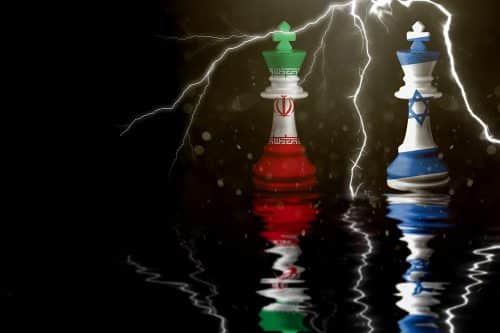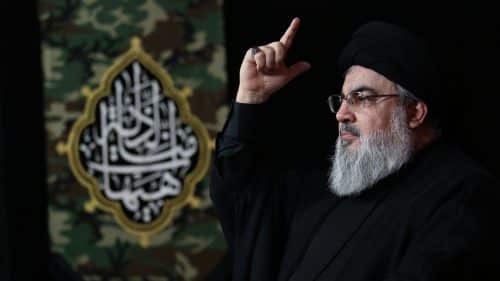It is against the backdrop of Iran’s critical water shortage that the recent US transfer of funds to the Islamic Republic should be appraised
When the well is dry, we know the worth of water—Benjamin Franklin (1705-1790).
The problem [of water scarcity] that threatens us — and is more dangerous than Israel, and the U.S., and political disputes…is the issue of the [survival] of the nation. The plateau of Iran is becoming uninhabitable…If the [water]situation is not corrected, in 30 years, Iran will be a ghost nation.”—Issa Kalantari, former Minister of Agriculture and Vice-President of Iran, Radio Free Europe, July 10, 2013.
While the attention of today’s international media is focused mainly on Iran’s drive for nuclear capabilities, another lingering issue, arguably no less grave, that menaces the future of the country, has received far less coverage. This is the question of water—or rather the lack thereof.
Inept government response to growing crisis
Almost a decade ago, I published an article entitled, Water, not heavy water, is Iran’s desperate need, which warned that: “Iran faces [an] unprecedented water shortage, so severe that much of the country could become uninhabitable and millions forced to emigrate.” In it, I quoted New York Times columnist, Thomas Friedman, who—citing informed Iranian sources—wrote: “…if Iran doesn’t radically change its water usage, 50 million people – 70 percent of Iranians – will have no choice but to leave the country.”
Today, the impact of water scarcity exceeds the inconvenience of household shortages and has become an increasing source of discontent and political disaffection, sparking demonstrations and clashes in recent years.
For example, CNBC reported that during the summer of 2021, protests flared in Iran’s western Khuzestan province over water shortages and ensuing power outages—as hydroelectric power stations came to a standstill. The demonstrations, dubbed “the uprising of the thirsty”, spread to several cities across the country—including the capital Tehran—precipitating a severe government crackdown, causing both police and civilian casualties.
Changes in climate have only exacerbated matters in a country, in which rainfall is scarce and temperatures can soar above a scorching 50 degrees Centigrade (nearly 125 degrees Fahrenheit). However, not everything can be blamed on deteriorating climatic conditions. Indeed, recent research seems to indicate that man-made initiatives and human activity—such as the construction of dams for irrigation and reducing the water table by drilling ever-deeper wells for the increased use of groundwater for agriculture –have contributed far more to the problem than natural causes.
Water scarcity as a source of domestic turmoil
The Washington Institute, in a 2022 study, Water Insecurity: Iran’s Formidable Threat, warned,”For decades, the Iranian government has failed to address the country’s water shortages, causing social unrest that will only intensify if the problems continue”.
The paper caustically admonished the inept water management in the country: “The Iranian government’s efforts to curb water shortages have been minimal to non-existent”, and cataloged a slew of ongoing water-related protests.
Thus, painting a bleak picture of Iran’s hydrological prospects, it noted: “Iran is already experiencing social disturbances that will only increase in intensity because of water shortages. It is estimated that 97% of the country is experiencing drought to some degree… Isfahan is one of the provinces that is mostly affected by the water shortages and its citizens have demonstrated several times as a result. In 2013, for example, farmers clashed with security forces, and smashed a pipeline transporting water to Yazd.”
According to the study, the unrest persisted and spread: “Demonstrations took place again a year later against the drying up of the Zayanderood river, and in 2018 there were anti-government chants, 25 were killed, and 3,700 were arrested. Demonstrations because of water shortages…took place in other provinces. In Khuzestan, a province that is responsible for 16% of Iran’s GDP and has 80% of Iran’s offshore oil reserve, demonstrations against water shortages and pollution morphed into anti-government protests. Another protest against water pollution and shortages took place in the city of Abadan…
It sums up with a gloomy prognosis: “…there is every reason to expect that Iran will continue to face punishing droughts, whether this year or in the near future, leading to further social unrest.”
Water & Domestic Turmoil (cont.)
Iran has been afflicted by drought for decades but in recent years, the problem has deteriorated gravely, aggravated by poor water management and driven by misguided political priorities. According to one UN water specialist, misguided policies promoting agriculture and ill-conceived development projects have led water consumption to outstrip supply for so long that there is virtually no way to reverse the current depletion.
Even in the capital Tehran, drought is compelling water cuts while gravely impacting inland water bodies such as Lake Urmia in North-West Iran, once the largest lake in the Middle East, and the sources of livelihoods it once provided, sparking large-scale migration from the countryside to urban areas.
Indeed, Lake Urmia conveys a graphic portrait of the country’s dire hydrological situation. A 2021 BBC report described a “shoreline…littered with crumbling hotels and beached boats…and abandoned orchards, abandoned fields, and abandoned houses, many of whose owners have sought new fortunes elsewhere.” Although there was some cautious optimism regarding the prospects for the restoration of the Lake—which, at one stage, shrunk to 10% of its original area—pessimism has again set in as to its fate. One of the most strident critics of Iran’s hydrological plight, and the policies that precipitated it, is Issa Kalantari, formerly Minister of Agriculture and Vice-President of Iran.
A looming catastrophe “no government can survive”
In August 2022, he underscored that in the past three decades, the lake has lost 95 percent of its volume–this despite government claims that it has channeled hundreds of millions of dollars to address the problem.
Ominously, Kalantari warned that: “If the lake is not restored, it will have security consequences, and no government can survive in the country because it cannot withstand the flood of migration of millions of people who reside near it“.
He presented a grim ecological prognosis for the Lake’s environs, including for one of Iran’s largest cities, Tabriz, which could face devastating pollution from clouds of wind-borne dust and salt particles, and would have to be evacuated because of the ensuing health implications: “Considering the fact that [Lake Urmia] has 13 billion tons of salt in its bed, if the lake dries up completely, the city of Tabriz should be evacuated…[E]ven if this evacuation is possible, it will cost at least one trillion US dollars“—far more than double Iran’s annual GDP!
Kalantari’s dour outlook is supported by numerous other sources, which attest to the threat being relevant to other parts of the country—including Tehran. Indeed, one account suggested that up to 60% of the country is vulnerable to dust and particle hazards. Thus, around one thousand kilometers and more south of the luckless Tabriz, the scourge of drought-driven dust storms afflict the area. Under the evocative headline, “From wetland to wasteland”, the Guardian describes how “…dust storms have overtaken the cities of Ahvaz, Soosangerd and Dezfu “, obscuring the sky and blocking out the sun, and how once navigable rivers have been reduced to a filthy polluted trickle.
Water as a source of foreign tension
Beyond its domestic woes, Iran is engaged in a number of disputes over shared water resources with some of its neighbors. In several cases of cross-border rivers that flow into its territory, Iran is situated downstream from its neighbors and thus is vulnerable to any upstream activity they may undertake.
Thus, for example, the water shortage in Iran has been exacerbated by growing tensions with its neighbors, particularly Afghanistan. These have increased since the Taliban retook the country in 2021. The dispute focuses mainly on the waters of the Helmand River, the longest river in Afghanistan, which flows westward from the Hindu Kush mountains into the Hamoun wetlands that straddle Iran’s eastern border with Afghanistan.
Iranian grievances focus mainly on the operation of Afghani dams—such as the Kajaki and the Kamal Khan dams—which diminish the amounts of water reaching the parched Sistan and Baluchistan province—where the dire state of the once productive Hamoun wetlands was graphically described in a New York Times review as “a landscape full of ancient history and modern decay: hut-like homes sitting in the dust where a lake used to be; camels and sheep drinking from dribbles of rainwater, all the moisture their owners could find; men marooned at home for lack of fish”.
Disputes over dams
Prior to the August 2021 US withdrawal from the country, with the Taliban more incumbered by military concerns, hydrological issues were a less urgent priority—something which worked in Iran’s favor. However, since the US exit, Afghanistan has become increasingly demanding in asserting what it perceives as its legitimate water rights.
In May 2023, Iranian and Afghan Taliban forces clashed on the border causing numerous casualties including two fatalities. AP reported exchanges of “heavy gunfire” as tensions between Tehran and Kabul over water rights escalated.
Water disputes between Iran and Afghanistan date back 150 years to the 1870s, but dam construction on the Helmand River in the 1950s exacerbated tensions. Eventually, in 1973, the two countries signed a treaty on sharing water resources. However, in practice, the accord was neither ratified nor implemented. In February 2021, Iran and Afghanistan signed a further agreement based on the 1973 accord, but disputes over dams remained unresolved.
There is thus little cause for optimism. According to some researcher estimates, the amount of Helmand River water reaching Iran has dropped by more than half over the past two decades. Given the construction of new dams and the expansion of irrigated farming in Afghanistan, there seems little chance that the tensions over water will decline. Quite the opposite, there is growing concern that a warming climate and political instability will fuel more frequent and more intense conflicts.
Detrimental dams
Afghanistan is not the only neighbor with whom Iran has a dispute over water.
For example, discord with Turkey over transboundary waters and dam construction on the Aras and Tigris rivers is emerging as a major factor underlying the strains in relations between the two countries.
Tehran alleges that Turkey’s massive Ilisu Dam, recently constructed on the Tigris, creates environmental risks to both Iran and Iraq. Iranian officials accuse Turkey of responsibility for damaging dust storms due to drought, caused by reduced water flows into the Tigris and Euphrates.
Turkey has also constructed dams on the Aras River, which flows south-east from Turkey, along the borders of Armenia and Iran, and via the Kura River into the Caspian Sea. These dams have been of particular concern to Tehran, prompting one concerned academic to sound the alarm that regional development plans by the Turkish government, including projects to construct dams on the Aras River, will result in the drying out of three Iranian provinces. West Azarbaijan, East Azarbaijan, and Ardebil.
Last May ,Iranian Foreign Minister, Hossein Amir Abdollahian, told members of the Iranian Shura Council that Turkey’s decision to build dams would harm the Iranian people and negatively affect water flowing into the Islamic Republic and declared that Ankara’s behavior was “unacceptable”. Just how gravely Tehran views the issue was reflected in the words of the speaker of the Iranian parliament, Mohammad Bagher Ghalibaf, who stated that Iran viewed the issue as a national security one.
Iraq: Troubled relations over water
Iran’s relations with another neighbor, Iraq, over water are also adversarial.
In 2021, Iraq was reportedly planning to file a lawsuit with the International Court of Justice against Iran over water cuts.
Iraq’s Minister of Water Resources, Mahdi Rashid Al Hamdani, alleged that his country has received only one-tenth of the volume it was receiving in the past from Iran.
In order to address its domestic water shortages, Iran has undertaken an extensive initiative for the construction of dams to divert water from rivers such as the Arvand, Karkheh, Karun, and Sirwan to other drought-afflicted provinces across the country. But limiting the flow from these rivers has significantly exacerbated the water crisis in southern Iraq. This has gravely diminished the supply of drinking water and disrupted agricultural irrigation systems in Iraq. These rivers are some of the principal sources of livelihood for the inhabitants of the Kurdistan Region of Iraq, making their situation extremely grave.
Accordingly, the outlook for transboundary water cooperation between Iran and Iraq appears bleak, with water resource management complications potentially driving Iran to disregard Iraq’s interests entirely. If this scenario unfolds, a major conflict over water between the two countries may be imminent, particularly as it could be perceived as the Shiite-Islamic Republic withholding water from Sunni-majority country.
Fungibility and Folly
Iran’s nuclear ambitions are not an issue usually associated with the country’s dire—and deteriorating—hydrological predicament. There is, however, one important link between them that is seldom articulated, despite its critical significance.
The link between them is the huge resources the country will require to contend with the water crisis. After all, the Iranian authorities will have very little flexibility in addressing the scarcity of water—whether this involves increasing the availability (by, say, desalination, which to date produces a minimal amount compared to the overall national requirement); or dealing with the consequences of its unavailability (such as drought-driven population displacements). Accordingly, every dollar Tehran is compelled to spend on dealing with the water shortage is a dollar siphoned off from its nuclear program. Conversely, every dollar provided to Iran to deal with the water issue will free up an additional dollar for the nuclear program.
It is in this light that the prudence of the recent decision by the Biden administration to allow the transfer of six billion dollars from frozen Iranian accounts for use by Tehran, allegedly for humanitarian use, in a controversial prisoner exchange in which five American citizens—mostly of Iranian descent, were released from Iranian prisons.
According to top Biden aides‘ somewhat optimistic assessments, financial sanctions and strict monitoring will prevent Iran from spending the money on anything except food, medicine, and other humanitarian goods. However, they concede, that the deal might free up money that Iran is already spending on those items for other purposes.
Fungible (cont.)
The move was savagely criticized by Republicans. Michael Mccaul (R-TX) caustically pointed out: “We all know money’s fungible. And then the president of Iran just came out and said, I’m going to spend it however I want to. And of course he is. And guess where it’s going to go? It’s going to go into terror proxy operations. It’s going to go into building their nuclear – you know, their nuclear not defense system but offensive system.”
There seems little doubt as to who is right in this case.
After all, the Iranian President, Ebrahim Raisi, stated baldly that it is up to his government to decide how it will spend the money, asserting that: “Humanitarian means whatever the Iranian people need…This money will be budgeted for those needs and the needs of the Iranian people will be decided and determined by the Iranian government.”
The stark question that now is to be addressed is will the US and its western allies utilize Iran’s grave hydrological plight to nudge the radical theocracy away from its nuclear ambitions and compel it to focus on more mundane matters—such a quenching its parched nation’s thirst.
Dr. Martin Sherman spent seven years in operational capacities in the Israeli defense establishment. He is the founder of the Israel Institute for Strategic Studies (IISS), a member of the Habithonistim-Israel Defense & Security Forum (IDSF) research team, and a participant in the Israel Victory Project





